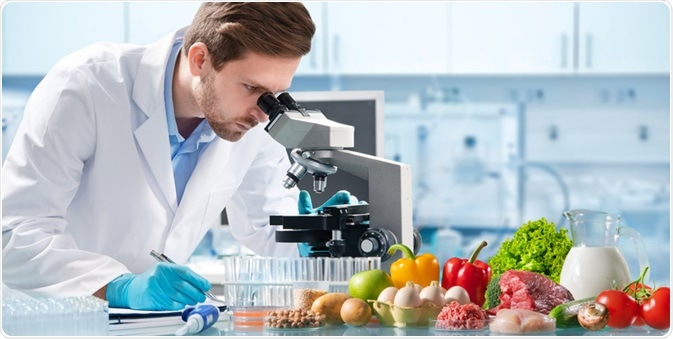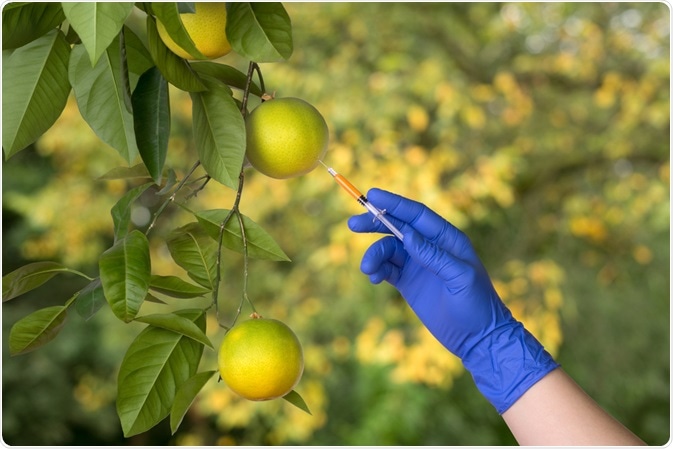Food science has many different applications, from improving flavors to designing suitable products for use in space. By looking at microbial, enzymatic, and genetic techniques, we explore some of the ways that biotechnology has been used in food science.

Image Credit: Alexander Raths/Shutterstock.com
What is Food Science?
Food science is a broad field covering the science behind food production and its processing, making use of biological, chemical, and engineering concepts.
Food can be adapted through genetic and environmental factors or by supplement addition, aiming to affect features such as crop growth, sensory qualities (taste, texture, aroma), or nutritional content. Biotechnological applications – those that use biological systems or their derivatives – are wide-spread in food science and can cross-over between different processes.
Microbial Uses
Microbes are used to varying degrees in many different food-based processes, including fermentation, enzyme production, and food supplements. The benefits on offer from using microorganisms in biotechnological food-based applications range from improved process efficiencies to sensory attributes and health effects.
Being generally regarded as more stable than those from animals and plants, microbial enzymes are widely used in food processes. These microbial enzymes aim to improve overall yields, shelf-life, and sensory features.
They play a role in food processes, such as fermentation, and can be used to adjust food characteristics, such as speeding up their ripening times and altering firmness.
Examples of enzyme applications include naringinase, which is a debittering enzyme that reduces the bitterness of citrus fruit juices; and lactase, which breaks down lactose and is added to milk to lower lactose intolerance.
Fermentation uses microbial cells and their substrates to generate desirable changes in food (preservation, taste) and is responsible for making products such as cheese, soy sauce, and alcoholic drinks.
Fermented microbial cells have also been used in the design of alternatives to meat products, such as mycoprotein. Here, fungal mycelial are fermented to produce a protein-based substance that is subsequently mixed with further ingredients, such as fats, binding agents, and flavorings.
Compared to chemical and synthetic routes, enzymes perform well under mild conditions and at low concentrations, while being specific for a given substrate, reducing costs and by-products.
But enzymes can also be problematic during food processes, where they can cause excessive or undesired breaking down of substrates. Alternatively, the conditions used in food processes can be too harsh for enzymes, damaging the enzymes and rendering them ineffective.
To overcome this, liposomes – lipid bilayer-based nanomaterials – have been developed to encapsulate enzymes, protecting them from harsh conditions, while protecting substrates from premature enzyme activity. These liposomes have been used in cheese making processes, where cheese firmness was improved by restricting protease action on casein.
Microbial cells can also be the focus of a food product — as with probiotics and prebiotics. Probiotics are food substances that contain selected microorganisms that have a beneficial effect on the host. Whereas, prebiotics focus on supplying substances to the gut, promoting growth and activity of a given microorganism that has a beneficial outcome on the host.
Probiotics aim to promote healthy microbial colonization in the gut flora, which helps to protect people from intestinal pathogens, particularly after antibiotic use. They are also being looked into for protection from diseases such as ulcerative colitis and colorectal cancer, as well as diarrheal treatment.
Prebiotics generally take the form of naturally occurring carbohydrates found in substances such as fruit, vegetables, milk, and honey, and have been added-in to infant formula milk and spreads.
While they aim to promote the colonization and growth of beneficial microbes in the gut flora, they can also alter its metabolic activity. Consequently, they have been shown to lower low-density lipoprotein levels in the blood and reduce infections.

Image Credit: photka/Shutterstock.com
Genetic Modifications
Traditional genetic modifications of crop and animal products relied on crossbreeding techniques to select for preferred characteristics. As genetic techniques advanced, gene editing technologies became available to perform specific modifications to an organism’s genome, known as genetically modified organisms (GMOs).
While GMOs divide public opinion, with some countries banning their use, their applications can provide many benefits, from environmental to nutritional aspects.
Tomatoes were the first GMO crop to be available commercially. Their shelf life was improved by lowering expression levels of an enzyme (polygalacturonase) that is responsible for the softening of tomatoes.
Since then, crops have been genetically modified to have pest, pathogen, insecticide, and herbicide resistance; higher nutritional content; and improved resilience to environmental conditions (droughts or high salinity soils).
Conclusion
Biotechnological techniques have been widely applied to the field of food science, from improving fermentation to developing probiotics. Exploration of new biotechnological-based methods to improve the yields, nutritional content, sustainability, and benefits of food products will continue to be an active area of food science research.
References
- Fellows, P. J. (2009) ‘Food biotechnology’, in Food Processing Technology. Elsevier, pp. 229–270. doi: 10.1533/9781845696344.2.229.
- Markowiak, P. and Ślizewska, K. (2017) ‘Effects of probiotics, prebiotics, and synbiotics on human health’, Nutrients, 9(9), doi: 10.3390/nu9091021.
- Potter, N. N., and Hotchkiss, J. H. (1998) Food Science. 5th edn. New York: Springer Science+Business Media, LLC. doi: 10.1007/978-1-4615-4985-7.
- Raveendran, S. et al. (2018) ‘Applications of microbial enzymes in food industry’, Food Technology and Biotechnology, 56(1), pp. 16–30. doi: 10.17113/ftb.56.01.18.5491.
- Shukla, S. et al. (2017) ‘Current demands for food-approved liposome nanoparticles in food and safety sector’, Frontiers in Microbiology, 8, pp. 2398. 10.3389/fmicb.2017.02398.
- Terefe, N. S. (2016) ‘Food Fermentation’, in Reference Module in Food Science. Elsevier. doi: 10.1016/b978-0-08-100596-5.03420-x.
- Zilberman, D., Holland, T., and Trilnick, I. (2018) ‘Agricultural GMOs—What We Know and Where Scientists Disagree’, Sustainability. MDPI AG, 10(5), pp. 1514. doi: 10.3390/su10051514.
Further Reading
Last Updated: Jul 21, 2020